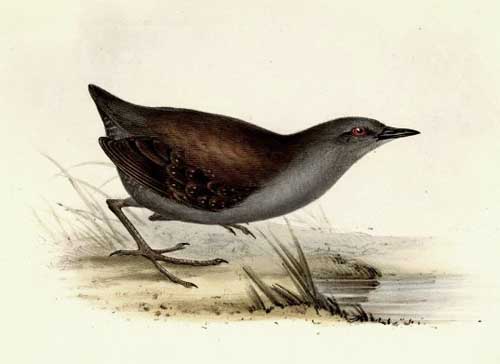
Fr: Râle des Galápagos
All: Galapagosralle
Esp: Polluela de Galápagos - Burrito Galapágico
Ita: Schiribilla delle Galapagos
Nd: Galápagosdwergral
Sd: Galapagosrall
Illustration :
John Gould: 1804-1881
Text by Nicole Bouglouan
Sources :
HANDBOOK OF THE BIRDS OF THE WORLD Vol 3 by Josep del Hoyo-Andrew Elliott-Jordi Sargatal - Lynx Edicions - ISBN : 8487334202
Ecology and Behavior of the Galapagos Rail
By Alan B. Franklin, Deborah A. Clark and David B. Clark
BirdLife International (BirdLife International)
Galapagos Rail
Laterallus spilonotus
Gruiformes Order – Rallidae Family
INTRODUCTION:
This small rail is secretive and usually difficult to see, although it can be tame sometimes. This bird remains on the ground, moving among the dense vegetation. Often heard and rarely seen, the Galapagos Rail is endemic to these islands.
DESCRIPTION OF THE BIRD:
Biometrics:
Length: 15-16 cm
Weight: 35-45 g
The adult has dark brown upperparts with small, scattered white spots on wings and from mantle to uppertail-coverts.
On the underparts, neck and breast are dark slate grey. Flanks and belly are chocolate brown with small white spots. The undertail-coverts are blackish and barred white.
The head is slate grey with blackish face.
The bill is black. The eyes are crimson. Legs and feet are blackish-grey.
The female is similar but she may have paler throat.
The non-breeding adult has reduced or absent white spots on the upperparts.

The juvenile is greyer on face and throat, with blackish-grey upperparts. The underparts are sooty-brown with no white spots. The eyes are black first, changing gradually through brown to orange, and finally to crimson. From an observation, the transition from chick to adult requires 80-85 days.
RANGE:
The Galapagos Rail occurs on Pinta, Fernandina, Isabela, Santiago, Santa Cruz, Floreana and San Cristobal islands.
HABITAT:
The Galapagos Rail may occur in two habitat types, but today, this species is no longer known from the coastal mangroves on any island. However, the highland moist areas with grass and forest where it frequents deep thickets and dense ground cover appear suitable for this species.
It usually adapts to man-modified habitats and cultivated areas, but it avoids overgrazed short-grass pastures by introduced herbivores. This species occurs higher than 500 metres on all islands, and can be seen up to 1700 metres of elevation on Isabela.
CALLS AND SONGS: SOUNDS BY XENO-CANTO
The Galapagos Rail has a wide vocal repertoire with cackles, clucks, warbles, trills and hisses.
The frequently heard advertising territorial song of adults is a rapid “chi-chic-chi-chirroo” ending into falling slur in the last note “rroo”.
BEHAVIOUR IN THE WILD:
The Galapagos Rail feeds primarily on various invertebrates such as snails, spiders, dragonflies, moths, Isopoda, Amphipoda, Hemiptera, ants and caterpillars. It also takes berries and seeds.
It forages on the ground and appears very active. It walks with depressed tail, darting the head from side to side in search of food. It jabs the bill actively into the leaf litter, picks up and tosses or removes leaves and twigs to find the hidden preys.
But it also takes preys from stems and overhanging vegetation. It probes into the moss on Miconia trunks, and may climb into the vegetation for foraging, but only up to 50 centimetres.
It also forages in shallow water at pools, streams and bogs. It wades with water at breast-level and catches preys from water surface.
During the breeding season, the Galapagos Rail is monogamous and territorial. The adults give loud, advertising calls, uttered more frequently or continuously at the beginning of the season.
From some observations, the courtship displays include “bill fencing” and mutual preening. During the nesting period, both mates share the nesting duties. Each turn for incubation involves several minutes of mutual preening while both mates sit in the nest. During the nesting period, they forage within 15 metres from the nest-site.
Other displays include mild or vigorous “foot-stamping” according to the situation. The bird remains in one place and raises and lowers the feet alternately in walking motion. In more vigorous action, the bird drums the feet, lifting each foot off the ground alternately while the body is held forwards and low from the ground.
The tail is erect during these displays, but the “tail-erection” display is often performed, with the tail cocked at 45 to 90°. The rectrices are fanned in a semi-circle.
If the bird is alarmed, some quick, jerky movements are performed while the tail is erect. In nest defence, the adult spreads its wings over the nest entrance.
The Galapagos Rail is resident in its range. It may occasionally fly but it usually runs.
REPRODUCTION OF THIS SPECIES:
The breeding season occurs from September to April.
The nest is on the ground, usually covered by thick low vegetation. It is made with grass stems. This is a deep semi-domed structure with side entrance.
The female lays 3-5 pale buff eggs with darker speckles. Both parents share the incubation during 23-25 days, with turns every 50 minutes. At hatching, the chicks are covered with black down. They have black eyes. The bill is white with black tip.
They leave the nest very soon and follow their parents which care for and feed them, although the juveniles are able to feed themselves. They remain in family group until they are almost fully grown. They can breed at one year old.
This species may produce two broods per season.
PROTECTION / THREATS / STATUS:
The Galapagos Rail is vulnerable to the introduced predators such as rats, cats and dogs. The Short-eared Owl and the Barn Owl are natural predators. Both introduced and natural predators attack and kill the chicks at nest.
Overgrazing by introduced goats, cattle and horses involve the degradation of the habitat. Invasive plant species such as Cinchona reduce fern and sedge vegetation types favoured by this species.
Although living in a protected Natural Park and with active conservation measures, the Galapagos Rail is listed as Vulnerable.